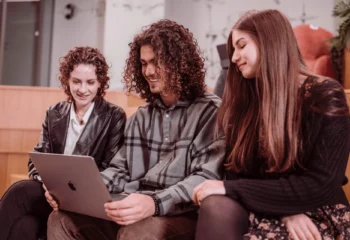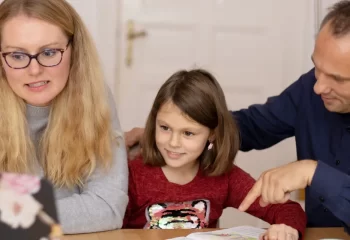Flexible classroom ideas mean more than just the seating of the chairs and how the students are grouped. It refers to the flexibility the teachers give the students to have their voices heard and listened to.
And yes, the teaching model that implies sitting at a desk with the teacher up front does contribute to allowing the students to have a voice and a choice. It just makes them feel under some rules and that the teacher has the power and they need to listen.
The importance of flexibility in the classroom
Flexibility in a classroom environment is not a 2022 need or discovery. It is a need that children have felt for a long time and is essential for their development and evolution.
There are so many reasons why flexibility is essential, and they all start with the confidence students feel you have in them once you allow them to express themselves. Give students credit, and they will show you they know how to learn without being pushed from the back. Showing this, they will just learn at their best.
Creating and accepting flexibility in the classroom as a teacher heightens collaborative learning and shows children their needs as far as learning concerns are heard.
Examples of flexibility in the classroom
Flexible instructional approach
A lot depends on the approach teachers have to teach. While some teachers would instead just demonstrate their knowledge of the course by following the traditional way and delivering the course to the students, then telling them to learn it at home, some listen to the class. When they see the course raises no interest, they start over.
What does that mean?
This means they ask students to say what is the best way they want to hear the course or what part of the course raises their interest and focus on that. These are responsive teachers are flexible and are not afraid of turning their classroom into a flexible one.
More than this, it is a great way to show students that you know their learning abilities are just as necessary as the instructional level you must follow in that class. And to achieve this, teachers must put in the extra effort. The balance is the key to this.
Flexible learning space
Offering a friendly space to children helps them feel comfortable and lowers the stress level a formal classroom environment can bring.
The truth is that one size fits all is no longer enough for today’s children and society’s needs. A flexible classroom design means a lot – it is a fact that “classrooms designed to support participative learning increased student engagement compared to traditional row-by-column seating.” (Darby, Alexa. “Understanding Universal Design in the Classroom.” National Education Association. Elon University, http://www.nea.org/home/34693.htm.)
Writing options
Being flexible as far as taking notes is concerned is a way to support a flexible learning environment. Ditching the pen and paper does not only contribute to sustainability and protecting the environment; more, it allows students to opt for a better and more appropriate form of taking notes – the iPad, NoteBook, Erase Pads etc.
E – learning
Online learning is an excellent example of a flexible learning environment. In teh online space, students feel more comfortable; they can be in their own space where they perform better.
Flexibility and Adaptability in the classroom
Flexibility in the classroom begins with the teacher. As long as the teacher is open to having flexible courses, learning procedures, discussions, and sitting arrangements, students are more than happy to contribute to a new learning type.
While adaptability takes a while, making it easier for students to learn will fill the hard work teachers should sometimes put into transforming the traditional class into a flexible one.
Adaptability involves flexibility in educational provision without changing the entire system and dissolving it into chaos. In times of global crisis, children may experience increased vulnerability due to changing things. (UNICEF 2020). This asks for a high adaptability level. Being able to function effectively as a teacher asks for adaptability to change and to the needs of the students.
Flexible seating in the classroom
“Spaces that are flexible, accommodating different approaches and uses, improve the odds for effective learning” (Oblinger, 2006, Learning Spaces)
flexible seating rules
As flexible seating is an integral part of the students’ and teachers’ lives, it must be based on some structure.
The structure provides safety and a focus on learning. Make an inviting classroom arrangement while also having a structured classroom.
Some of the rules of good flexible seating in the classrooms are:
- Let students know there are some basic rules to follow for the flexible learning environment to work.
– Always ask and give feedback
– Listen to the needs of all students
– Offer exercises to students to actively participate in the lesson
– Have periodic reviews to see the level of understanding students have
flexible seating classroom furniture
– Bean bag chairs
– Duvet lounger
– T – stools
– Therapy ball
– Sensory swing
– Portable laptop stand
– Cushions
Advantages and disadvantages of flexible seating
The impact of flexible design in the classroom is rather hard to quantify as many variables are to consider. However, if you use the same variables and just change the seating, you might see how a flexible design classroom impacts students’ overall academic achievement.
Advantages
A flexible classroom seating is an excellent idea for students and teachers alike because:
– Encourages collaboration and communication
– Fosters ownership and engagement – more than this, students are more likely to respond to learning when they feel comfortable. The line that traditional classroom seating forms does not allow the engagement students need to have with the teacher and between themselves
– Boosts confidence
– Increases movement “they are more engaged and can better anchor new info and experience into neural networks.” when they move around the classroom and use various senses to process information. (Smart Moves, Why Learning is Not All in Your Head, Carla Hannaford)
– Improves focus.
– Increases the well-being of students
– Helps have better academic results
– Builds mutual respect and trust between teachers and students
Disadvantages
Being stuck in the same environment can lead to a stuck view of learning and a stuck mind. Thus, there are indeed more advantages to a flexible learning environment than disadvantages.
However, some may feel that a few worthy disadvantages are worth considering.
– Hard to implement in a class with many students
– Assigned seating helps the class be under control and avoid unnecessary discussions about the seating arrangements.
– Can create chaos if students are not ready to make decisions
Alternative seating arrangements in the classroom
Somewhere along the way, students feel that the traditional seating arrangements form a line between them and the teacher. And that line is the one that contributes to making them uncomfortable and stressed.
Tables can be gathered in groups and use various seating options to feel the utmost comfort. You can use exercise balls, stools, wobble chairs, bean bags, and pillows. Students are different and may prefer different seating options; thus, offering a wide range to choose from is a great idea. When students can make their own choices, productivity and engagement increase.
Conclusion
A student’s success does not depend on a single thing, nor is the teacher responsible for the student’s academic success. Many variables contribute to the academic success of students. Making the student’s life comfortable and being attentive to the student’s needs is one step closer to having a successful outcome. If the classroom seating, flexible education, and teachers’ approaches make a difference, let’s try these educational perks and see their benefits.
“Flexible spaces alter the fundamental dynamics of teaching and learning, giving students more control and responsibility, improving academic engagement, and undermining the typical face-forward orientation of the traditional learning environment.” (Peter Barrett of University of Oxford) (Cox, Janelle. The Flexible Classroom Management Option. TeachHub.com, https://www.teachhub.com/flexible-classroom-management-option.)
Flexibility in the classroom FAQ
How can teachers best demonstrate flexibility in the classroom?
Allowing students to “guide” the lesson is a great way to show flexibility in the classroom.
How do you create a flexible classroom environment?
Being able to create a flexible classroom environment needs adaptability. A teacher that has high adaptability can make a great flexible environment through:
– Flexible topics
– Open discussions
– Group sessions
– Different ways to take notes
– Various seating options
How does seating arrangement affect learning?
Seating arrangements can affect learning. It is the feeling students have while sitting in a traditional seating arrangement classroom where they are all facing the teacher and the teacher is the guide while they are the listeners. This seating arrangement forces them to “pay attention” and just take notes.
A flexible seating where there is room to share a discussion, interact and collaborate with the teacher, and to be able to move can improve students’ engagement.
What is the purpose of flexible seating in the classroom?
Flexible classroom seating wants to increase students’ understanding and interaction in the class.
Why is flexibility important in the classroom?
It is important especially for students as they feel there are no constraints and their needs are heard.




